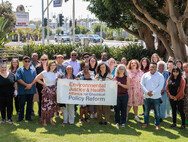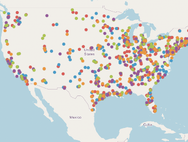

Media
Media
Share this page:
Latest News
The latest updates from the Environmental Justice Health Alliance for Chemical Policy Reform and our affiliated and allied organizations.
- Click here for just EJHA in the news.
- Click here for In Our Words, EJHA's blog.
- Click here for press releases and our media center.
Deidre Nelms
(802) 251-0203 ext. 711
dnelms[at]comingcleaninc.org
Trump Is Using the Shutdown to Supercharge His War on Equity
October 9, 2025
As the federal government shutdown stretches into its second week, President Donald Trump is targeting nearly $30 billion in cuts to federal funding almost exclusively to Democratic states and cities. The impact of the cuts to public transit, energy projects, and fundamental civil rights programs could carry far-reaching harms across the nation and the economy. The cuts are the next step in the implementation of executive orders issued by Trump that strive to eradicate policies that advance racial and gender equity, tackle the climate crisis, and threaten the fossil fuel industry. "When the Biden-Harris administration came in, they did not just create plans in a vacuum, they went and listened to people in the community” to learn what projects were needed, “and financing flowed from those discussions,” Michele Roberts of the Environmental Justice Health Alliance. The programs included projects to address historic and ongoing environmental racism and injustices, and the disproportionate health and economic burdens in Black and Brown communities that followed.
Community, Health, and Environmental Groups Sue to Stop President Trump’s Unlawful Toxic Air Pollution Exemptions
October 22, 2025
WASHINGTON, D.C. – Community, health, and environmental groups sued the Trump administration today to stop an executive action that would unlawfully exempt 50 of the country’s most toxic chemical manufacturing plants from protections that guard people against dangerous cancer-causing air pollutants, including ethylene oxide and chloroprene. “We’ve fought for decades to close loopholes and get real checks on chemical leaks. These standards target the dangerous chemicals that create a huge cancer risk in communities like Mossville, Louisiana, and others throughout the country,” said Michele Roberts, national coordinator of the Environmental Justice Health Alliance for Chemical Policy Reform (EJHA). “Delaying them is a policy choice with a human cost, measured in diagnoses, not dollars. The Clean Air Act doesn’t allow a president to waive our human right to health or hand polluters a free pass without evidence.”
Read More
We're hiring an EJHA Administrative Associate
October 14, 2025
Coming Clean is seeking part-time, short-term administrative support for the Environmental Justice Health Alliance for Chemical Policy Reform (EJHA). The EJHA Administrative Associate will report to, and take direction from the EJHA National Organizer.
Read More100 Orgs & Individuals with Environmental Justice Networks Say to EPA: Revoking Endangerment Finding Puts All Our Communities in Danger
September 30, 2025
NATIONWIDE – In response to the Environmental Protection Agency (EPA) seeking to remove the Endangerment Finding and revoke vehicle emissions regulations, a coalition of environmental justice networks submitted written comments – signed by 100 organizations and individuals – alongside a powerful collection of testimonies that capture the real-world impacts of climate and transportation pollution and frontline and fenceline communities’ need for robust protections. The coalition of environmental justice groups warn that EPA’s decision undermines their mission and puts millions of lives at risk, placing environmental justice communities in the greatest danger. They also share a clear set of demands: The EPA must stop its proposal to revoke the Endangerment Finding and Greenhouse Gas Vehicle Standards, renew its commitment to environmental justice, restore essential funding, and commit to regulations that protect current and future generations.
Read MoreChemical Incident Tracker updated after EPA deletes data
September 18, 2025
The Coalition to Prevent Chemical Disasters published updates to its open-access chemical disaster tracking tool today that allow users to see how close they live to highly hazardous facilities covered by the U.S. Environmental Protection Agency’s (EPA) Risk Management Program (RMP). The Chemical Incident Tracker continues to allow users to search for chemical releases, fires and explosions that have been reported in the media since January 2021, using an interactive map. The tracker is updated with new incidents weekly.
Read MoreMedia Share this page: |
What Is Environmental Justice? | Campaign for Healthier Solutions | Campaign for Healthier Solutions |
THE ENVIRONMENTAL JUSTICE HEALTH ALLIANCE IS IN STRATEGIC PARTNERSHIP WITH COMING CLEAN
info@comingcleaninc.org • (802) 251-0203 • EJHA – Coming Clean, 28 Vernon Street, Suite 434, Brattleboro, VT 05301
© 2026 Coming Clean Inc.




